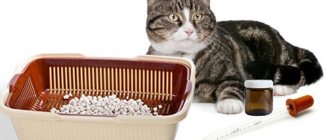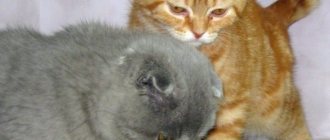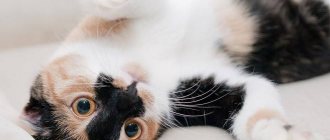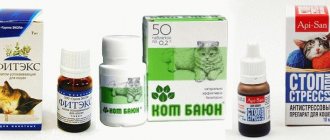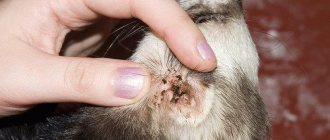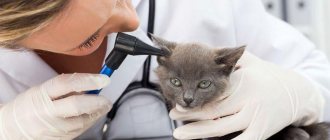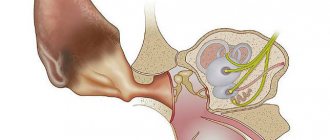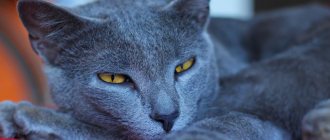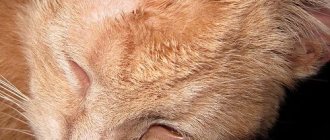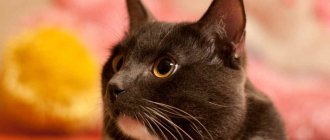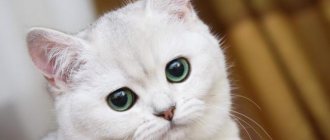Green, juicy grass for cats is a complete, affordable food in a pet’s diet. Young shoots contain the vitamins, minerals and fiber necessary for your pet. Planting grass is not difficult: in summer - on a summer cottage, in winter - on a windowsill. Having at your disposal the usual seeds of any cereal and a suitable container, you can provide your cat with fresh herbs, even without sowing them in the ground, at any time of the year.
Self-grown grass is a good alternative to indoor and garden flowers, most of which are dangerous to your pet’s health.
Benefits and harms
The beneficial substances contained in the herb have a beneficial effect on the health of the pet, namely:
Normal hematopoiesis in an animal occurs thanks to chlorophyll.
- Fiber improves digestion and cleanses the stomach of undigested food particles through the gag reflex.
- Vitamins and microelements strengthen the pet's immunity.
- Chlorophyll has a positive effect on the brain, supplies the body with oxygen, and participates in the process of hematopoiesis.
For improved intestinal function, including loosening stools, veterinarians recommend giving your pet sprouted seeds, and narrow blades of grass for strengthening. Grass can cause harm to your pet if the cat has eaten greens treated with herbicides. Domestic cats that are not outdoors and deprived of the opportunity to eat grass can encroach on potted indoor plants, most of which contain toxins that are dangerous to the animal.
Can a cat eat hay?
Once in the supermarket, the author of the article saw hay for rabbits and thought that the cat would probably like to roll around in it and smell the smell. And so it happened. But before the cat began to wallow, she began to greedily eat the hay. Can a cat eat dried grass?
On the one hand, hay can perfectly cleanse the stomach if wool is clogged in the gastrointestinal tract. How? So is the grass. Either push through or induce vomiting. But the trouble is that hay consumed in too much quantity can itself clog the intestines. It is unlikely that it will come to an operation to remove it, but it is still unpleasant.
The author’s cat, after eating a lot of hay, stopped bowel movements for a couple of days, although before that she had bowel movements every day. Then she walked off on her own, without help. Hay was still available, but the cat had already satisfied its greed and only occasionally came up to eat. Mostly it was lying around in the box with it.
Conclusion: dried grass consumed in small quantities does not lead to problems - in the following days the cat nibbled on the hay and went to the toilet as usual. However, if you bring home hay and see your cat's insatiable appetite, it is still better to remove the grass from access. Avoid eating large quantities at once.
Rate and share!
Can you grow it at home?
To grow your own grass, you need cereal seeds, a suitable container and soil. There is a way to grow grass at home without soil. You can buy different types of grass seeds for cats at a pet store or regular grain at the farmer's market. 2-3 glasses of cereal grains are enough to provide your pet with vitamin greens for the whole season. Lush grass grows quickly under greenhouse conditions, but you need to ensure that the greens do not dry out ahead of time by moistening and spraying the soil. It is good to sow the seeds in several containers at once with an interval of 3-4 days, so that while the cat eats the first harvest, new shoots will grow in the second tray. If it is impossible to grow grass at home, you can buy ready-made greens without chemical additives, the name of which is “Grass for Cats” from the Titbit brand. There are step-by-step instructions for the fortified food. The disadvantage is the high price.
Method without soil
Cat grass seeds germinate well even without soil. For this method, gauze or bandage is used.
How to grow grass on cheesecloth:
- Take a plastic container and make drainage holes at the bottom.
- Before germination, seeds are soaked in warm water for 1-2 hours.
- The gauze is folded into 2-3 layers and moistened.
- Line the bottom of the plate with gauze, place the seeds on top and cover with another layer of damp gauze.
- Keep the container in a warm place, periodically adding water.
Miss Clean magazine advises buying seeds only in special departments. In the markets you may find low-quality material treated with chemicals.
What kind of grass do you need?
Fluffies can eat lemon balm.
Cats can be given plants such as:
- Melissa;
- cat mint;
- thyme;
- valerian;
- oats;
- wheat;
- rye;
- barley.
Valerian, mint, lemon balm, thyme, lemongrass excite your pet or, conversely, calm it down. Such herbs are more attractive to animals due to their smell. Cats prefer to eat cereals. Sprouts of fresh grass in winter are very useful. This is the best vitamin supplement for the animal’s excellent well-being. Outdoor cats eat a grass called sow thistle, known as weed. But it has medicinal properties that have a beneficial effect on the health of the pet. An animal with fur of any color, be it gray, red, black and white, outdoor or indoor, needs fresh greens.
The most favorite herb for furry pets is sprouted oats. The young cereal is rich in folic acid, carotene, potassium, magnesium, silicon, and is therefore recommended by veterinarians for inclusion in the diet of a pregnant cat and a growing kitten.
Create a cat garden in a plate
Many pet owners are interested in learning how to grow grass for cats in a plastic dish.
- To do this, select a plate of the required size and make several holes in it.
- Soak the grain, and then pour it into a plate and cover with gauze.
- Create a greenhouse and leave it in a warm place. In a couple of days the first shoots should appear. Don't forget to water once every 3 days.
- After a week, you can offer the cat a treat. This method is classified as a one-time method, since the grass quickly dies.
If you are thinking about which grass cats eat better: indoor or outdoor, then remember that picking vegetation from someone else’s flowerbed is dangerous - there may be worms, causative agents of distemper and other dangerous diseases.
You should not buy seeds at the market or from unfamiliar sellers - this can be dangerous. Unscrupulous traders treat them with chemicals and aggressive substances, so your pet may get sick.
It is better to purchase them from pet stores or from reliable sellers. Not all cats love grass. If your animal does not show any interest in it, then there is no need to force it. Perhaps the body does not need greens.
Some owners mix grass into food, believing that this way the cat will receive additional vitamins or cleanse the intestines through vomiting. Veterinarians consider such measures unnecessary and unsafe.
How to plant?
Growing seeds without soil
During the growing period, seedlings should be covered with gauze.
If you don’t have soil at hand, you can germinate oats for your cat using 2 plastic plates of different sizes and cotton wool. The yield with this method of germination is lower than when sowing seeds in the ground. After your pet eats the greens, they need to be re-sowed. The procedure for planting grains without a substrate is as follows:
- Make holes in a small plate to get rid of excess water.
- Moisten the cotton wool and spread it along the bottom of the holed container.
- Place the smaller plate on top of the larger one.
- Place the grains on moistened cotton wool.
- Cover the sown seeds with gauze.
- Wrap both plates in film and place on the windowsill.
- After seed germination, remove the polyethylene.
- Water the young grass little by little with clean water 1-2 r. in a day.
Method of planting in the ground
If soil was used to germinate grains, then the owner of the fluffy will be able to reap several harvests.
In another way, oat grass is planted using garden soil, substrate or soil for flowers. You can sprout greens in a pot, but to ensure stability, it is better to take a container with a wide base and sides up to 5 cm. Grass for cats grown in the ground is removed more than once. You can plant oats for cats in the ground like this:
- Pre-soak the grains in water for 1 hour.
- Pour soil into the prepared container.
- Moisten the soil base.
- Spread the seeds on a moistened substrate.
- Sprinkle a layer of earth no more than 1-2 cm on top.
- Add water.
- Stretch the film on top to create a greenhouse effect.
- Leave the mini-garden for 3 days at the optimal temperature for germination, 24-25°C, during which time the seeds should germinate.
- Remove the polyethylene after 4 days and place the container on the windowsill.
- After a week, young green shoots can be offered to your beloved pet.
Growing rules
There are many ways to grow grass for your pet. For example, you can take the planting technique using soil as a basis. To do this, you need to purchase the grass itself, a balanced soil mixture, and a container from a specialized store. If you don’t want to buy a pot, you can make it from scrap material.
In addition, for planting you will need polyethylene, which will completely cover the container. You can use a regular plastic bag as it. In order for the root system of plants to develop correctly, it is necessary to ensure good drainage. The seeds themselves can simply be soaked or germinated to speed up growth.
After planting, they must be sprinkled with soil and moistened with water at room temperature, sprayed from a spray bottle. Then the planted seeds should be covered with plastic film, creating a greenhouse effect. After successful shoots, the film is removed, however, if the room where the grass is grown is very dry, the sprouts will have to be covered with film for the first time. This is necessary so that they do not dry out, as this will lead to the death of the roots.
You can plant grass for cats without soil, and this method is considered simpler. To implement this, you will need two plastic plates of different sizes. The bottom of one must be pierced to create drainage and remove excess water. The holed plate is placed inside the whole one so that it does not rest entirely on the bottom.
A little cotton is placed on the bottom, then the cotton is moistened, and after that the seeds are laid on it. The seeds are covered on top with gauze with large holes through which sprouts can grow. To speed up germination and prevent drying out, cover the top of the plate with plastic wrap. The method is convenient because, even if they want to, the pets will not scatter the soil, and in addition, the breeder will not have to prepare a substrate for planting.
For an improvised lawn, instead of a substrate, you can use a certain cat litter (for example, from compressed sawdust). It is soaked until a homogeneous consistency is obtained, after which it is used as soil. Otherwise, the method is no different from the option of planting in a pot with soil.
After the shoots appear, the grass needs to be provided with proper care, which will accelerate its growth and affect rapid rooting, as well as juiciness.
- You will have to water the soil daily, but so that it does not stand in water. At first, it should be moistened with a fine water spray. Water for irrigation must be filtered or boiled.
- Do not place the container with sprouts in a hot place, as this will lead to rapid evaporation of water from the soil (cotton wool, filler).
- The location for the container must be chosen correctly: drafts that can freeze the grass are unacceptable (relevant in winter for plants located on the windowsill).
- Cat grass takes an average of 2 weeks to grow. There is no need to grow grass for months: after the deadline, it will begin to age, lose its juiciness, it must be renewed so that the cat always has a fresh portion.
- The layer of soil that is sprinkled on the grass when planting should not be thick, otherwise it will be difficult for the seeds to germinate through the soil. In addition, with a large layer, germination will take a long time. It is a mistake to assume that it should be up to 3 cm: ideally 1 cm is enough.
- Lack of light and temperature during cultivation will result in stunted grass. For optimal growth and succulence, it needs to be provided with all aspects of care, including not only watering, but also light and moderate temperature.
- In summer, you can grow grass on a windowsill or outside. However, it is worth considering that it will have to be treated to remove dust so that the pet does not inadvertently eat it along with the necessary substances.
- To speed up germination, the seeds selected for planting can be soaked in water. Soaking time usually does not exceed 2 hours. The water should not be too hot; it is advisable to use settled or filtered water.
Top articles: The impact of climate change on the planet's wildlife
What herbs should a cat not eat?
After eating ivy, your pet will simply become poisoned.
Indoor flowers are dangerous for cats, most of which contain poisonous juice. Especially harmful are philodendron, dieffenbachia, alocasia, monstera, ficus, azalea, caladium, spurge, croton, oleander, adenium, cyclamen, delphinium, ivy, and chrysanthemum. Garden flowers such as lilies, gladioli, tulips, hyacinths, lilacs, pansies, carnations, snowdrops, and primroses are harmful. If a cat eats indoor plants, he is in danger. Once inside, a small piece of a poisonous plant can seriously harm a pet’s health, for example, cause a burn to the mucous membranes, vomiting, diarrhea, provoke nervous disorders, impair coordination, cause kidney failure, heart problems, lead to loss of vision if toxic juice gets into the eyes, possible cases of death. At the first signs of poisoning, you need to provide first aid to the animal and immediately contact a veterinarian.
To protect your pet from dangerous plants, you should not keep them in the house or prevent the animal from accessing flower pots and vases with bouquets. Citrus peels, which cats really dislike, are suitable for this purpose. It is placed near dangerous plants. Also, cats do not like rue, onions, and wormwood.
Why and why do cats eat grass? Whim or need
Everyone has seen more than once how cats and kittens, domestic and stray, small and adult, greedily eat fresh grass. Why are they doing that? There are several key reasons, the main one being need.
This is why it occurs:
- To induce vomiting. This laxative effect helps when overeating or during times of discomfort, forcibly helping the body cleanse itself.
- Replenishment of the diet. Due to its richness in vitamins, eating grass replenishes unbalanced nutrition necessary for normal growth and functioning of the cat's body.
- Increased oxygen content in the blood. This is especially necessary for a pregnant cat.
- Cleaning the stomach from hairballs. And since these animals wash themselves around the clock: from morning to evening and from evening to morning, this need is present every day.
- Having fun. Even for this reason, many of the cat family consume plants, enjoying the tasty juice and greedily smacking their lips.
Best articles: The influence of nature on humans: arguments
In general, it turns out that nature decided everything for the cats. Due to the fact that the “mustachioed” eat a lot of unnecessary things (skin, entrails, bones, wool), it is necessary to carry out a general cleaning of the stomach. All blades of grass, entering the body, “vacuum” it and remove waste, undigested food, and hair residues.
Provide safe cleansing for your pet.
8(495)150-55-58
www.belanta.vet
Our address: Moscow, st. Brateevskaya, 16/3 Shcherbinka, st. Sports, d12a
The veterinary clinic is open 24 hours a day
Green, juicy grass for cats is a complete, affordable food in a pet’s diet. Young shoots contain the vitamins, minerals and fiber necessary for your pet. Planting grass is not difficult: in summer - on a summer cottage, in winter - on a windowsill. Having at your disposal the usual seeds of any cereal and a suitable container, you can provide your cat with fresh herbs, even without sowing them in the ground, at any time of the year.
Self-grown grass is a good alternative to indoor and garden flowers, most of which are dangerous to your pet’s health.
